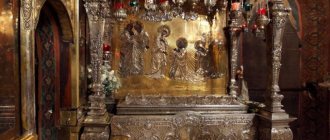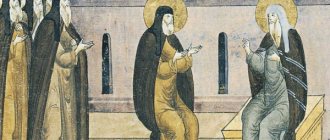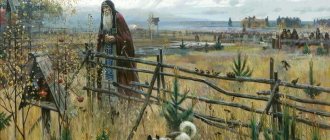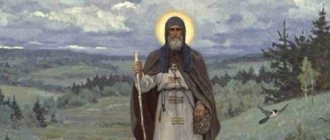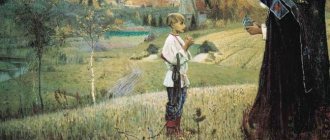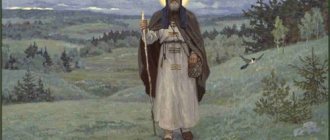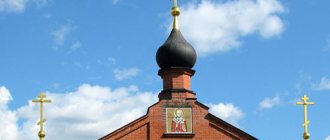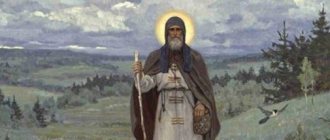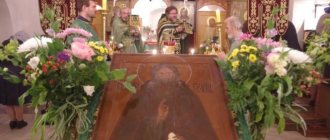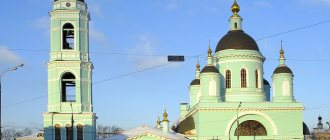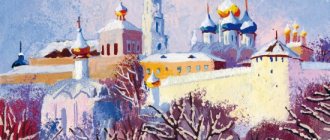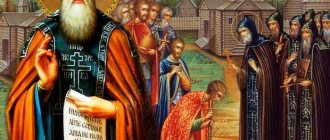Biography
Little is known about the life of Sergius of Radonezh, hieromonk of the Russian Church, reformer of monasticism in northern Rus' and founder of the Holy Trinity Monastery. Everything we know about the “great old man,” canonized, was written by his disciple, the monk Epiphanius the Wise.
Sergius of Radonezh
Later, the life of Sergius of Radonezh was edited by Pachomius the Serb (Logothetus). From it our contemporaries draw information about the main milestones in the biography of the church leader. In his biography, Epiphanius managed to convey to the reader the essence of the teacher’s personality, his greatness and charm. The earthly path of Sergius recreated by him makes it possible to understand the origins of his glory. His life path is indicative in that it makes it clear how easily any difficulties in life are overcome with faith in God.
Minin and Pozharsky. 1610
You cannot ignore the history associated with Minin and Pozharsky. After all, it is known from history that the comrade-in-arms of the governor Prince Pozharsky in the pious cause of expelling the Catholic interventionists was the landowner and butcher by trade Kozma Minin. He was distinguished by chastity and other virtues, loving silence, he always had God in his heart. One day, the Wonderworker Sergius of Radonezh appeared to him in a dream and ordered him to collect money and soldiers and go to Moscow, where the Polish king, who was preparing Rus' to accept the union, wanted to take the Russian throne.
At first Minin did not attach any significance to his dream. The landowner thought: “Well, who am I to deal with such important matters, and who will listen to me?” But then the dream repeated itself twice more, and Minin, eventually repenting of his disobedience, decided on a God-pleasing deed. Minin and Pozharsky began to gather people throughout Rus'.
On March 19, 1611, a spontaneous uprising against the interventionists began in Moscow; the Poles were unable to resist it and locked themselves in Kitay-Gorod and the Kremlin and burned Moscow. The situation was very difficult. Poles have settled in the capital, in the north-west the Swedes are seizing Russian lands, in the southern outskirts hordes of Crimean Tatars are rampaging...
However, on August 22-24, the interventionists had less than half of their troops left. The Poles suffered heavy losses. The hope of owning the Moscow state was irrevocably destroyed. This means that Saint Sergius of Radonezh, whose icon and cross was always of help to them, heard the prayers of the defenders of Rus'.
Analyzing all these events, you begin to understand that it is not in vain and not by chance that at the most difficult moment for the Russian land, every time people encounter the image of St. Sergius.
I would certainly like to note that in Orthodox Christianity, military service is a God-pleasing activity. The Church always teaches us patriotism and love for the Motherland. This is the meaning that is embedded in the description of the icon of Sergius of Radonezh.
Childhood
The date of birth of the future ascetic is not precisely known, some sources call 1314, others - 1322, others are inclined to believe that Sergius of Radonezh was born on May 3, 1319. At baptism, the baby received the name Bartholomew. According to ancient legend, Sergius’s parents were boyar Kirill and his wife Maria, who lived in the village of Varnitsa in the vicinity of Rostov.
Monument to the family of Sergius of Radonezh
Their estate was located not far from the city - in the places where the Trinity Varnitsky Monastery was subsequently built. Bartholomew had two more brothers, he was the middle one. At the age of seven the boy was sent to study. Unlike the smart brothers who quickly grasped literacy, the training of the future saint was difficult. But a miracle happened: in an amazing way the boy learned to read and write.
Epiphanius the Wise
This event is described in his book by Epiphanius the Wise. Bartholomew, wanting to learn to read and write, prayed for a long time and with zeal, asking the Lord to enlighten him. One day an old man in a black robe appeared before him, to whom the boy told about his trouble and asked him to pray for him and ask God for help. The elder promised that from that moment the boy would write and read and surpass his brothers.
They entered the chapel, where Bartholomew confidently and without hesitation read the psalm. Then they went to their parents. The elder said that their son was marked by God even before giving birth, when she came to church for the service. During the singing of the liturgy, the child, being in his mother’s womb, cried out three times. Based on this story from the life of the saint, the painter Nesterov painted the painting “Vision to the Youth Bartholomew.”
Painting “Vision to the Youth Bartholomew.” Artist Mikhail Nesterov
From that moment on, books about the lives of saints became available to Bartholomew. While studying the Holy Scriptures, the youth developed an interest in the church. From the age of twelve, Bartholomew devoted a lot of time to prayer and observed strict fasting. On Wednesdays and Fridays he fasts, on other days he eats bread and drinks water, and prays at night. Maria is worried about her son's behavior. This becomes a subject of controversy and disagreement between father and mother.
In 1328-1330, the family faced serious financial problems and became poor. This was the reason that Kirill and Maria and their children moved to Radonezh, a settlement on the outskirts of the Principality of Moscow. These were difficult, troubled times. The Golden Horde ruled in Rus', lawlessness arose. The population was subjected to regular raids and subjected to excessive tribute. The principalities were ruled by princes appointed by the Tatar-Mongol khans. All this caused the family to move from Rostov.
Monasticism
At the age of 12, Bartholomew decides to become a monk. His parents did not interfere, but set the condition that he could become a monk only when they were gone. Bartholomew was their only support, since the other brothers lived separately with their children and wives. Soon my parents died, so I didn’t have to wait long.
Monk Sergius of Radonezh
According to the tradition of those times, before their death they took monastic tonsure and schema. Bartholomew goes to the Khotkovo-Pokrovsky Monastery, where his brother Stefan is located. He was widowed and took monastic vows before his brother. The desire for a strict monastic life led the brothers to the bank of the Konchura River in the Makovets tract, where they founded a hermitage.
In a remote forest, the brothers built a wooden cell made of logs and a small church, on the site of which the Holy Trinity Cathedral currently stands. The brother cannot stand the hermit life in the forest and moves to the Epiphany Monastery. Bartholomew, who was only 23 years old, takes monastic vows, becomes Father Sergius and remains to live in the tract completely alone.
Painting “Reverend Sergius of Radonezh. (Blessing)". Artist Sergey Kirillov
A little time passed, and monks flocked to Makovets, a monastery was formed, which over the years became the Trinity-Sergius Lavra, which still exists today. Its first abbot was a certain Mitrofan, the second abbot was Father Sergius. The abbots of the monastery and students did not take alms from believers, living on the fruits of their labor. The community grew, peasants settled around the monastery, fields and meadows were reclaimed, and the former abandoned wilderness turned into a populated area.
Painting "Works of Sergius of Radonezh". Artist Mikhail Nesterov
The exploits and glory of the monks became known in Constantinople. From the Ecumenical Patriarch Philotheus, St. Sergius was sent a cross, a schema, a paraman and a letter. On the advice of the Patriarch, the monastery introduced the konoviya - a communal charter, which was subsequently adopted by many monasteries in Rus'. This was a bold innovation, since at that time the monasteries lived according to a special charter, according to which the monks arranged their lives as their means allowed.
Cenovia assumed equality of property, food from one cauldron in a common refectory, identical clothes and shoes, obedience to the abbot and the “elders.” This way of life was an ideal model of relationships among believers. The monastery turned into an independent community, whose residents were engaged in prosaic peasant work, praying for the salvation of the soul and the whole world. Having approved the charter of “common life” in Makovets, Sergius began to introduce life-giving reform in other monasteries.
LiveInternetLiveInternet
In July 2014, the 700th anniversary of the birth of St. Sergius of Radonezh, whose name is familiar to most Russians, was celebrated. Sergius is revered by the Russian Orthodox Church as a saint and is considered the greatest ascetic of the Russian land. This is an exceptionally bright historical figure, and it is not surprising that many artists have turned and are turning to his image.
Probably the most famous works dedicated to Sergius belong to the artist Mikhail Vasilyevich Nesterov. During his long creative life, he created a series of works dedicated to the life and deeds of the saint. The artist himself spoke about this: “I did not write and did not want to write history in paint. I wrote the life of a good Russian man of the 14th century, sensitive to nature and its beauty, who loved his homeland in his own way and strived for truth in his own way. “I pass on the legend composed in ancient years by my native people about the people whom they marked with love and memory.” The first work of the cycle was the painting “The Vision of the Youth Bartholomew,” painted in 1889-1890.
M. V. Nesterov. "Vision of the Youth Bartholomew"
The plot of the picture is based on the “Life of St. Sergius,” compiled by Sergius’s disciple Epiphanius the Wise. At the age of seven, the youth Bartholomew (as Sergius was called in the world) was sent to study with two brothers - Stefan and Peter. The brothers studied successfully, but Bartholomew was not given a diploma. One day, while looking for missing horses in the field, he saw an unfamiliar old monk under an oak tree. The monk prayed. The youth approached him and told him his grief. Having listened sympathetically to the boy, the elder began to pray for his enlightenment. Then, taking out the reliquary, he took out a small piece of prosphora and, blessing Bartholomew with it, said: “Take, child, and eat: this is given to you as a sign of the grace of God and the understanding of the Holy Scriptures.” Grace truly descended on the boy: the Lord gave him memory and understanding, and he began to easily assimilate book wisdom. (You can read more about this painting here).
This was followed by the painting “The Youth of St. Sergius” (1892-1897). Here we have before us the already matured Sergius, who has experienced the first difficulties of a hermit’s life. After the death of his parents, Bartholomew, together with his brother Stefan, retired to live in the wilderness in the forest (12 versts from Radonezh). First they built a cell, and then a small church, and, with the blessing of Metropolitan Theognostus, it was consecrated in the Name of the Holy Trinity. But Stefan could not stand the difficulties of living in a deserted place and went to one of the Moscow monasteries. Sergius was left alone. One day a hungry bear came to the saint’s hut. The monk realized that the beast was hungry and brought him a piece of bread. Having eaten the treat, the bear retreated into the forest, but from then on it often began to come to the saint’s cell. And the Reverend thanked God for sending him a fierce beast for consolation.
The figure of Sergius of Radonezh is depicted on a low forest hillock, against the backdrop of a wooden chapel, among birds and animals.
The artist and art critic A. N. Benois (1870–1960) called this landscape “a whole poem of the northern forest.”
M. V. Nesterov. "The Youth of St. Sergius"
In 1337, Bartholomew took monastic vows with the name of the holy martyr Sergius. Gradually he became known to other monks. The Monk Sergius received everyone with love, and soon a brotherhood of twelve monks was formed in the small monastery. Their experienced spiritual mentor was distinguished by his rare diligence. With his own hands he built several cells, carried water, chopped wood, baked bread, sewed clothes, prepared food for the brethren, and humbly performed other work. St. Sergius combined hard work with prayer, vigil and fasting. This is exactly how we see the saint in the triptych “The Works of St. Sergius” (1897).
M. V. Nesterov. Triptych "Works of St. Sergius", central part
M. V. Nesterov. Triptych "Works of St. Sergius", left and right parts
The work “Reverend Sergius of Radonezh” (1899) completes Nesterov’s “Sergius Cycle”.
M. V. Nesterov. "Reverend Sergius of Radonezh"
In 1881, Viktor Mikhailovich Vasnetsov created the icon “Sergius of Radonezh” for the church in Abramtsevo, built according to the design of Polenov and Vasnetsov himself. Here Sergius is depicted as a stern peasant with work-worn hands.
V. M. Vasnetsov. "Sergius of Radonezh"
In 1895, Vasnetsov painted another picture dedicated to Sergius of Radonezh. Here is a miracle with a source. One day the monastery ran out of water. Then Sergius found a place, baptized it with a cross and began to pray to the Lord for water to appear. And a miracle happened - a spring began to flow in this place.
V. M. Vasnetsov. "Reverend Sergius of Radonezh"
The saint occupied a special place in the works of Nicholas Roerich. In 1925, Roerich created the work “Sergius the Builder”. There are two paintings with this title. Both paintings with this title depict Sergius in his labors and a bear with him. “Let my painting “Sergius the Builder” remind of indestructible construction. Sergius is a hard worker, one of the founders of Russian cultural construction.” (N.K. Roerich. Indestructible)
N.K. Roerich. "Sergius the Builder"
In 1932, the painting “St. Sergius of Radonezh” was painted. “In the foreground of the picture is Saint Sergius of Radonezh, builder of churches and monasteries, bearer of the faith of Christ, peacemaker, clairvoyant, unconditional spiritual leader of Rus' in the 14th century. With his feet he stands on the Russian Land and at the same time, as it were, rises above it. Above everyone. Dressed in purple and blue monastic robes - the colors of the highest cosmic vibrations, denoting the highest spirituality. In his palms he holds a church - the Nerl Cathedral, the most ancient temple in Russia. The Nerl Cathedral personifies Russia itself. Therefore, the image of the towering Sergius holding the Nerl Cathedral can be understood as follows: Saint Sergius is the greatest patron of the Russian Land. This was especially evident at critical moments in history. This is also evidenced by the helmets and spears of the soldiers leaving for the Kulikovo field, and the stormy sky, foreshadowing the approach of a severe battle. Three circles on a white and blue board, denoting the unity of the past, present and future, imply: this was, is and will be a defense. The sign of the All-Seeing Eye, the Eye of Revelation in a violet triangle above the head of the saint in the anxious sky - a sign of the Divine Mind, a symbolic image of God - testifies that St. Sergius is carrying out his mission according to the Higher Will.” (Marchikhin S. Painting by N.K. Roerich “St. Sergius”)
N.K. Roerich. "St. Sergius of Radonezh"
The first biography of St. Sergius Epiphanius the Wise wrote that before the battle with Mamai, Grand Duke Dmitry Ioannovich, later known as Dmitry Donskoy, met with St. Sergius and received a blessing from him. Historians argue whether this meeting took place before the Battle of Kulikovo or an earlier battle on the Vozha River, but the plot exists and the artists could not ignore it.
Alexey Danilovich Kivshenko. “Reverend Sergius of Radonezh blesses the Moscow prince Dmitry Ivanovich for the battle with Mamai.” 1874
Alexander Nikanorovich Novoskoltsev.
And modern artists are inspired by the personality of St. Sergius. Sergei Nikolaevich Efoshkin dedicated a series of works to Sergius of Radonezh.
S. N. Efoshkin. “Reverend Sergius of Radonezh. Blessing of the Prince of Moscow Dimitri Ioannovich and his squad for the battle. 1380" 1994
S. N. Efoshkin. “Reverend Sergius of Radonezh. Appearance of the Blessed Virgin Mary" 1998
S. N. Efoshkin “Reverend Sergius of Radonezh. Across Rus'" 1998
The painting by Natalya Klimova tells about the miracle of the resurrection of a youth. The father carried his seriously ill son to Saint Sergius so that he would heal the child. But on the way the boy died. Then, leaving the body in the saint’s cell, the father went away in tears to get the coffin. Sergius began to pray to God for the boy, and then the boy opened his eyes and began to move. The artist depicted the moment of the father’s return, not yet knowing that his son was alive.
Natalya Klimova. “Resurrection of a boy by St. Sergius of Radonezh”
Vasily Nesterenko. "Hegumen of the Russian Land"
Yuri Raksha. “Blessing of Dmitry by Sergius of Radonezh”, left part of the triptych
https://ru.wikipedia.org
Yarovskaya N. (Roerich E.I.). Banner of St. Sergius of Radonezh
Sayetgalieva L.V. “The Image of the Reverend in Russian Painting”
https://gallery.facets.ru/
Series of messages “Christian saints in painting”:
Part 1 - Christian saints in painting. Saint Cecilia. Part 2 - Christian saints in painting. Saint Veronica. ... Part 4 - Christian saints in painting. Saint Barbara. Part 5 - Christian saints in painting. Saint Mary Magdalene. Part 6 - Christian saints in painting. Venerable Sergius of Radonezh. Part 7 - Christian saints in painting. Saint Bavo. Part 8 - Christian saints in painting. Saint Roch. Part 9 - Christian saints in painting. Saint Jerome.
Monasteries founded by Sergius of Radonezh
- Trinity-Sergius Lavra;
- Staro-Golutvin near Kolomna in the Moscow region;
- Vysotsky Monastery in Serpukhov;
- Annunciation Monastery in Kirzhach, Vladimir region;
- St. George's Monastery on the river. Klyazma.
Trinity-Sergius Lavra in Sergiev Posad
Followers of the saint’s teachings founded more than forty monasteries on the territory of Russia. Most of them were built in the wilderness. Over time, villages appeared around them. “Monastic colonization”, begun by Radonezh, made it possible to create strongholds for the development of lands and the development of the Russian North and Trans-Volga region.
Battle of Kulikovo
Sergius of Radonezh was a great peacemaker who made an invaluable contribution to the unity of the people. With quiet and meek speeches, he found his way to the hearts of people, calling for obedience and peace. He reconciled the warring parties, calling for submission to the Prince of Moscow and the unification of all Russian lands. Subsequently, this created favorable conditions for liberation from the Tatar-Mongols.
Sergius of Radonezh blesses Dmitry Donskoy
The role of Sergius of Radonezh in the battle on the Kulikovo field was great. Before the battle, Grand Duke Dmitry Donskoy came to the saint to pray and ask for advice on whether it was a godly thing for a Russian man to fight against the atheists. Khan Mamai and his huge army wanted to enslave the freedom-loving, but fear-ridden Russian people. The Monk Sergius gave the prince his blessing for the battle and predicted victory over the Tatar horde.
Sergius of Radonezh blesses Dmitry Donskoy for the Battle of Kulikovo
Together with the prince, he sends two monks, thereby violating church canons that forbade monks to fight. Sergius was ready to sacrifice the salvation of his soul for the sake of the Fatherland. The Russian army won the Battle of Kulikovo on the day of the Nativity of the Blessed Virgin Mary. This became another evidence of the special love and patronage of the Mother of God on Russian soil. The prayer of the Most Pure One accompanied the saint’s entire life; his favorite cell icon was “Our Lady Hodegetria” (Guide). Not a day passed without singing an akathist - a hymn of praise dedicated to the Mother of God.
Icon of Sergius of Radonezh. Photo
Everyone knows that icons of holy worshipers help people solve their problems. Therefore, I definitely want to know how the icon of Sergius of Radonezh helps. First of all, you need to know that only through sincere prayer and faith to this holy man and to God can people receive protection from any unpleasant life circumstances. Parents ask him for help in raising their children, protecting them from bad influences, giving them humility and taming their young pride, since this is the greatest evil, which later causes a lot of trouble. With all this, people turn to him with different requests.
The icon of Sergius of Radonezh is not noticeable. Her photo, however, makes us think about whether we are doing everything right, whether we are ready to sacrifice our lives for our Fatherland, as our heroic ancestors did at the prompting of the great seer.
Miracles
The ascetic’s ascent along the path of spiritual perfection was accompanied by mystical visions. He saw angels and birds of paradise, heavenly fire and divine radiance. The name of the saint is associated with miracles that began even before birth. The first miracle mentioned above took place in the womb. Everyone in the church heard the baby's cry. The second miracle is associated with unexpectedly revealed abilities for knowledge.
Sergius of Radonezh and the bear
The pinnacle of spiritual contemplation was the appearance of the Most Holy Theotokos, which the holy elder was honored with. One day, after selfless prayer in front of the icon, he was illuminated by a dazzling light, in the rays of which he saw the Most Pure Mother of God, accompanied by two apostles - Peter and John. The monk fell to his knees, and the Most Pure One touched him and said that she had heard the prayers and would continue to help. After these words, she became invisible again.
Appearance of the Most Holy Theotokos to Sergius of Radonezh
The appearance of the Most Holy Theotokos was a good omen for the monastery and all of Rus'. A big war with the Tatars was coming, people were in a state of anxious anticipation. The vision became a prophecy, good news about a successful outcome and impending victory over the horde. The theme of the appearance of the Mother of God to the abbot has become one of the most popular in icon painting.
Resistance to interventionists. 1608-1609
In 1608-1609, the Sergiev Posad land repulsed the invaders. For 16 months there were terrible battles. The Poles wanted to rob the monastery and kill the defenders, who during the times of great unrest remained faithful to their Fatherland. Then the governors were the okolnichy prince G.B. Roshcha-Dolgoruky and the nobleman Alexei Golokhvastov. These defenders were strong in spirit, and their monastery was full of faith and was under the protection of the great wonderworker Sergius. At his coffin everyone kissed the cross and swore that they would never surrender their monastery to the enemy. After heavy attacks and scurvy that began due to poor nutrition, which claimed hundreds of lives over many months, only about 300 warriors remained in the monastery, although initially there were 2,400 people. These insignificant forces of the monastery were opposed by 15 to 30 thousand of the best armed forces of the Polish governors Sapieha and Lisovsky, who also had 60 guns.
On the night of one of the most decisive battles, when thousands of Polish troops rushed to the fortress, the impossible happened. Their troops, due to some fatal mistake, heavy fog, or ridiculous orders from their superiors, shot themselves, mistaking allied troops for enemies. And the besieged also very courageously met the enemy with fire. The next morning, joy knew no bounds, as the enemy siege weapons were abandoned and the enemy fled. With the name of God, the support of the Mother of God and the Holy Father Sergius, the heroic Russian soldiers held out. They were confident that victory would be theirs.
There was a lot of evidence of how Saint Sergius of Radonezh helped and advised his soldiers. He even appeared in a subtle dream to one monk and suggested that an enemy mine was underway under the monastery, and then two peasants blew themselves up and this mine, thereby accomplishing a great feat in the name of God and the Fatherland.
I really want to hope that the icon of Sergius of Radonezh, the prayer to this saint and his veneration, even today, will not leave Russia without his support.
Death
The decline of Sergius, who lived to a ripe old age, was clear and quiet. He was surrounded by numerous disciples, he was revered by great princes and the last beggars. Six months before his death, Sergius handed over the abbess to his disciple Nikon and renounced everything worldly, “began to remain silent,” preparing for death.
Monument to Sergius of Radonezh
When the illness began to overcome him more and more, in anticipation of his departure, he gathers the monastic brethren and addresses them with instructions. He asks to “have the fear of God”, to maintain like-mindedness, purity of soul and body, love, humility and love of strangers, expressed in caring for the poor and homeless. The elder passed away into another world on September 25, 1392.
Memory
After his death, the Trinity monks elevated him to the rank of saints, calling him a venerable, miracle worker and saint. A stone cathedral, called Trinity Cathedral, was built over the saint’s grave. The walls of the cathedral and the iconostasis were painted by an artel led by Andrei Rublev. The ancient paintings were not preserved; new ones were created in their place in 1635.
Icons of Sergius of Radonezh
According to another version, the canonization of Radonezh took place later, on July 5 (18), when the relics of the saint were found. The relics are still in the Trinity Cathedral. They left its walls only when there was a severe threat - during fires and the Napoleonic invasion. When the Bolsheviks came to power, the relics were opened, and the remains were kept in the Sergiev Historical and Art Museum.
The modest Radonezh abbot gained immortality in the memory of his followers, all believers and in the history of the state. The Moscow kings, who attended pilgrimages in the Trinity Monastery, considered the saint their intercessor and patron. His image was turned to in difficult times for the Russian people. His name became a symbol of the spiritual wealth of Russia and the people.
Icons of Sergius of Radonezh
The dates of commemoration of the saint are the day of his death on September 25 (October 8) and the day of glorification of the holy monks of the Trinity-Sergius Lavra on July 6 (19). The saint’s biography contains many facts of selfless service to God. Many monasteries, temples and monuments were built in his honor. There are 67 churches in the capital alone, many were built in the 17th-18th centuries. They also exist abroad. Many icons and paintings with his image were painted.
The miraculous icon “Sergius of Radonezh” helps parents when they pray for their children to study well. In a house where there is an icon, children are under its protection. Schoolchildren and students resort to the help of the saint when they experience difficulties in their studies and during exams. Prayer before the icon helps in legal cases, protects against mistakes and offenders.
The Decisive Role of St. Sergius
Most historians agree that at that time the Venerable Sergius of Radonezh played a very important and major role in the unification of Rus' before the advancing formidable enemy. At that difficult moment, many Russian principalities, which had previously waged endless internecine wars, united into a single fist. Saint Sergius managed to do the literally impossible - to reconcile two religions that were warring at that time. He showed the Vedic Russians that the true teaching of Jesus Christ had nothing in common with Western Christianity, that Christ never taught to organize crusades, burn Vedic temples and heretics at the stake. He showed Russian Christians that true Christianity is as deep a teaching as their ancient faith, therefore there is no reason for religious hostility, since now perverted Christianity is coming from the West, where the most terrible and vile crimes are being committed under the name of Christ.
It is these unrest for Orthodox Rus' that the icon “Sergius of Radonezh” hides. Still, it was not for nothing that he was called “The Sorrower of the Russian Land,” since he never ceased to care for it and with his incessant prayers contributed to its spiritual uplift and liberation from the Tatar yoke.
